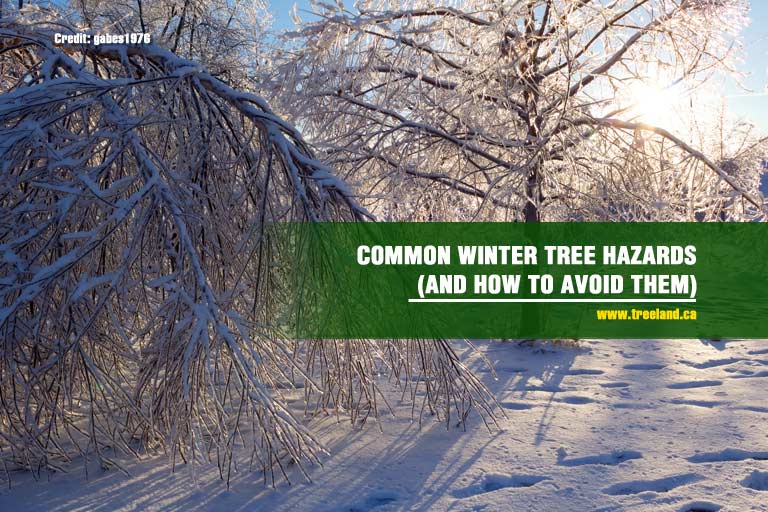
Homeowners who maintain well-manicured lawns often dread the arrival of winter simply because of the negative effects of extreme temperature on their precious ornamental plants, bushes, and trees. This is a reasonable concern, especially for people who have given the time, effort, and money invested in beautifying their lawns.
Now that winter is in full-force, we do not only need to pay close attention for potential tree damage but also for the potential tree hazards that can make your property unsafe. Ice and snow cause tree and landscaping hazards that can put both the household members and passersby at risk of injuries, which could result in expensive lawsuits.
Winter Tree Hazards to Watch Out For
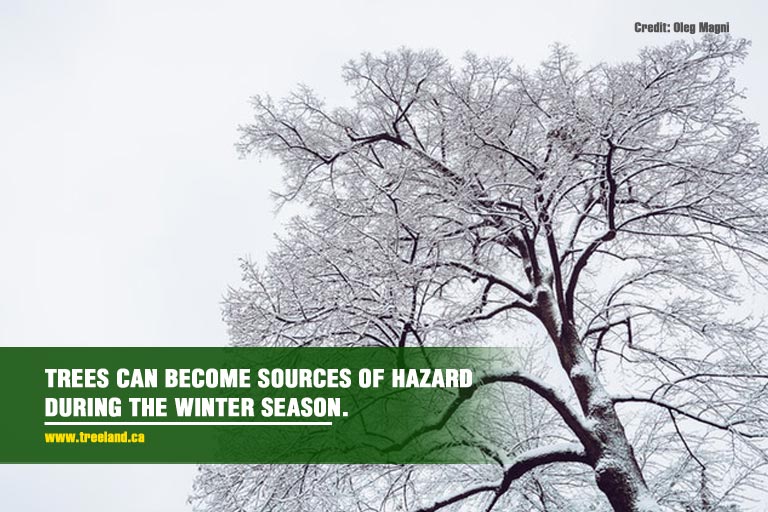
Trees offer amazing benefits to your property, such as wind protection, privacy, provision of shade and increased curb appeal. However, winter can turn trees into sources of danger.
In many cases, winter tree hazards can be a result of our failure to detect factors that can contribute to accidents and injuries. That is why it is highly advisable to hire a licensed arborist to annually perform a thorough inspection of your trees, prune dead or damaged branches, thin out canopies, and even treat diseased trees back to optimal health.
The freezing ice and snow can be too much, especially for trees in poor health conditions. Let us take a look at the different tree hazards in winter:
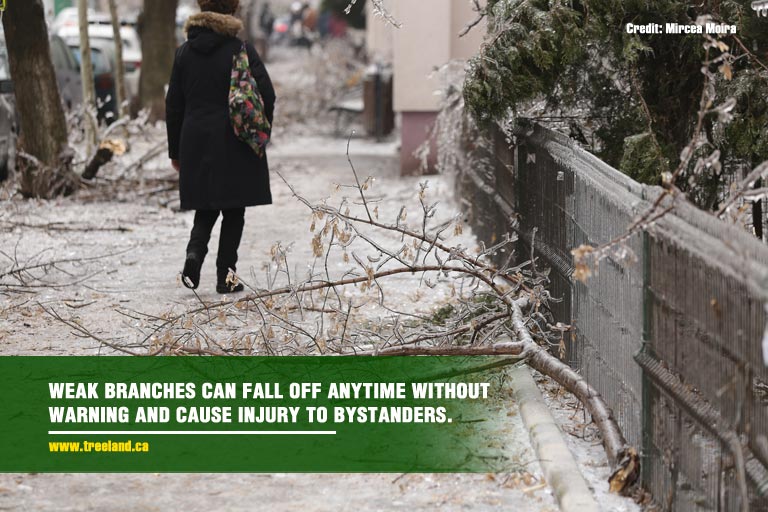
- Falling Branches – When freezing ice and snow accumulate on weak or damaged tree branches, the weight of the branches can become 30 times heavier than their original weight. Delicate, damaged, or dead branches can easily break during medium or heavy snowfall. Snow and ice can also increase the risk of decay the longer they adhere to the branches. Large branches can snap off and fall onto your house, car, or unsuspecting bystanders. Branches can fall and tumble down on power lines, causing power outages and potential electrocution due to the live wire touching the ground.
- Uprooted Tree – A leaning tree may not be necessarily at risk of being uprooted if its tilt is not pronounced. However, if the tree leans unnaturally or the tilt becomes distinctly increasing, or the ground shows signs of disturbed soil near the base of the tree, it may be in danger of uprooting. If you have a leaning tree in your yard, be sure to inspect the condition of the roots to check its stability.
- Multiple Tree Trunks – A large tree with multiple trunks does not necessarily mean a strong, sturdy tree. The area where the trunks are joined together tends to be weak, especially if the trunks are joined in a V-shape. If one or more trunks awkwardly lean outwards, they are at risk of breaking or falling during a snowstorm.
Signs of Hazardous Trees
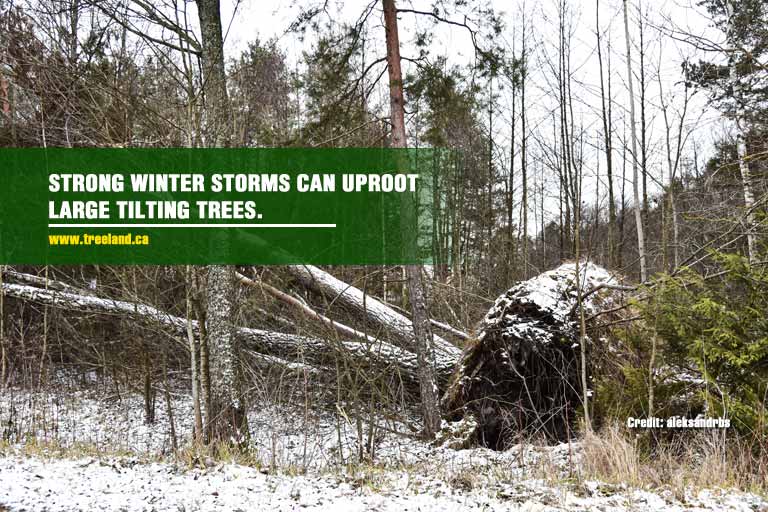
Trees can become hazardous over time and may require tree moving services to transfer them to a safer area in your property. To protect your home from damage and the people around you from accidents and injuries, make sure to address them ahead of time.
Here are several signs of winter tree hazards to watch out for:
- A tree with branches that are too close to your home could cause significant damage to your roof or windows.
- Small broken branches can get stuck and clog the gutter, causing the formation of thick ridges of solid ice or ice dams or allowing water to seep into your home.
- Long, large, weak branches that are near your house could cause potential ice dams.
- Young, weak-wooded trees, such as certain species of aspen, and willow, could easily break and fall off.
- Trees leaning at more than 15 degrees angle are more likely to be uprooted and should be immediately removed to prevent the danger of falling. However, be wary that tree removal may come with risks if not properly done.
Types of Trees That Can Be Hazardous During Winter
- Cottonwood (Populus) – When the roots of the Cottonwood spread, it can crack and damage sidewalks, patios, and the structural foundation of your home. Its weak wood can easily break during strong wind or storms.
- Honey Locust (Gleditsia triacanthos) – This tree is highly susceptible to insects and bugs, such as honey locust borers, mimosa, webworms, galls, leafhoppers, midges, whiteflies, canker diseases, mites, and root collar rot.
- Weeping Willow (Salix babylonica) – Extreme cold temperature may cause cracks, canker, and rot. They also attract various pests like caterpillars, borers, and gypsy moths.
Evaluating Tree Hazards
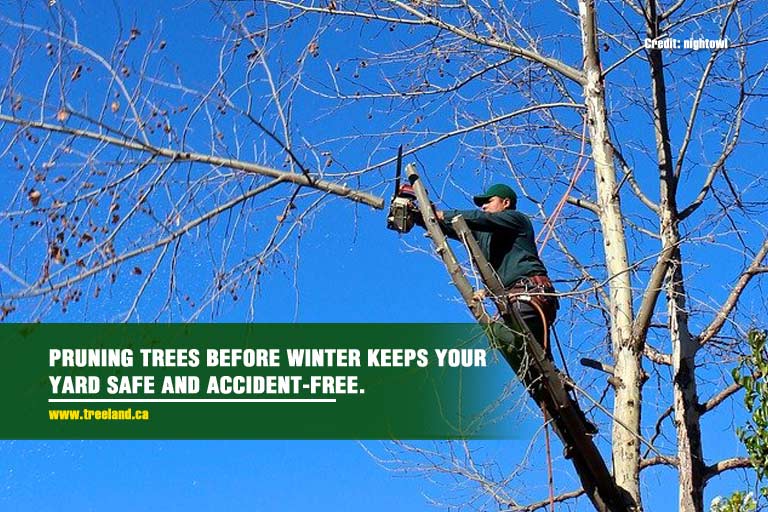
One of the most critical factors in hazard tree management is tree age. While every tree has a different life span, the risk of failure increases with its age. Other essential factors to consider that will help you determine a tree’s hazard potential include longevity and environment.
Here are what you can do evaluate the potential hazard of a tree:
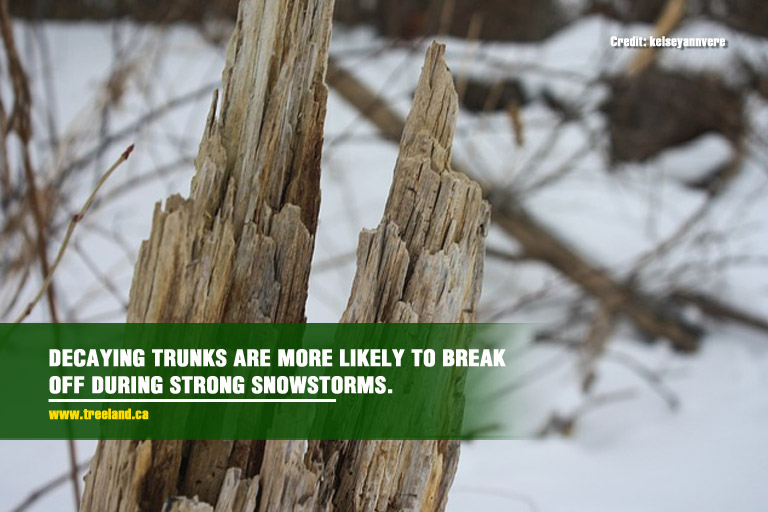
- Inspect the Trunk – When fungi grow on a tree and reproduce, they weaken the wood and cause decay. Unlike a healthy tree, its wood fibres are flexible as it bends and sways. However, the wood tissues of a decaying tree are not flexible and can easily break when exposed to strong wind. In some cases, a decaying tree may not exhibit obvious signs, making it hard to detect. Moreover, dead branch stubs, cracks, swells, cankers, and old wounds may be signs of internal decay.
The presence of wounds and cankers could make a tree hazardous. These tree defects weaken the trunk and increase the likelihood of tree failure. The direction of the wind may influence the risk of falling or breaking. For instance, the risk of breaking at the wound or cancer is higher if the tree is facing or opposite to the direction of the wind.
- Examine the Crown – Crown characteristics that make a tree potentially hazardous include lopsidedness, dieback, and V-shaped forks. Stress can cause the upper crown branches to die from the top down. Root disease, repeated insect defoliation, drought, and soil compaction expose the tree to stress. Additionally, the invasion of pests and the growth of fungi can cause further problems.
- Check the Health and Integrity of the Roots – The condition of the root should never be underestimated. Unhealthy, damaged roots affect the vitality of the tree, as well as increases the risk of failure. Among the signs of poor root conditions include dwarfed, off-coloured leaves, thin crowns, stunted growth and resin-soaked wood. Also, check rot fungi growing at or near the base of the tree.
Although some homeowners may prefer removing the tree from their property, others choose to move the tree to a safer location, away from your house or people. At Caledon Treeland we have specialized equipment to move large trees safely. Call us today at (905) 880-1828 to book a tree moving service in the GTA.
